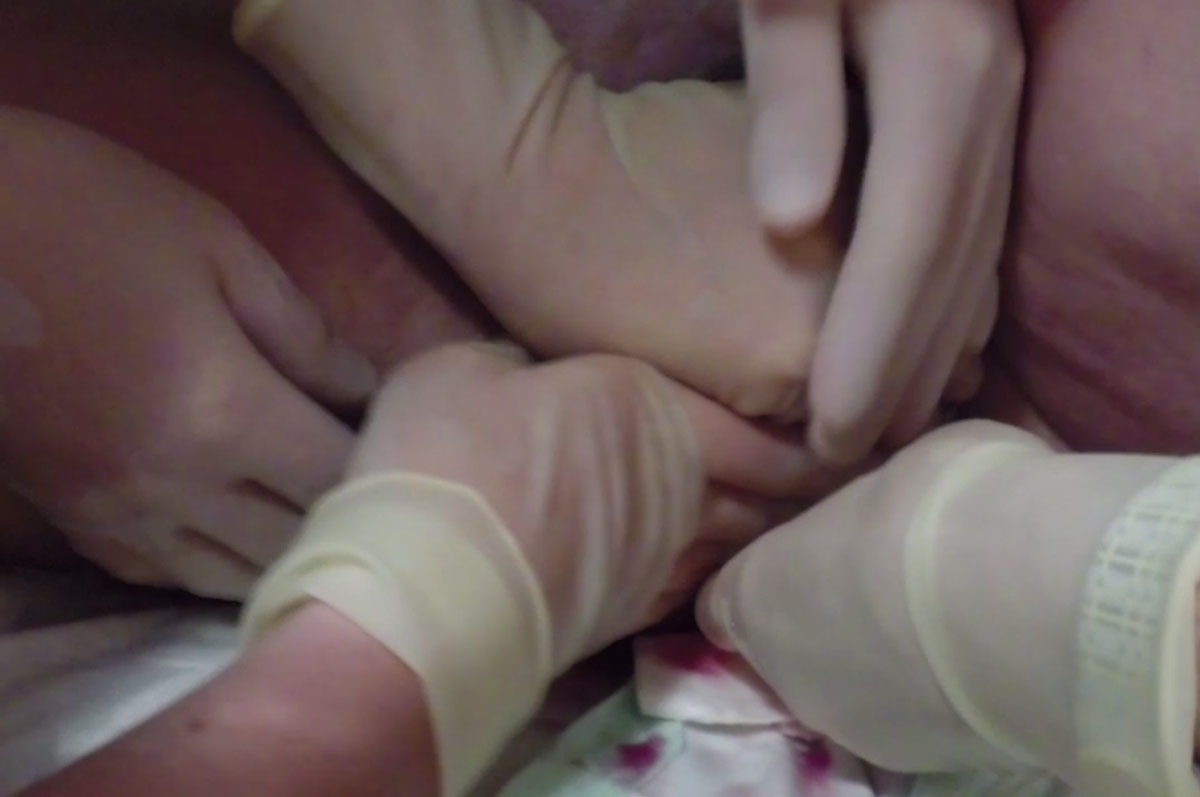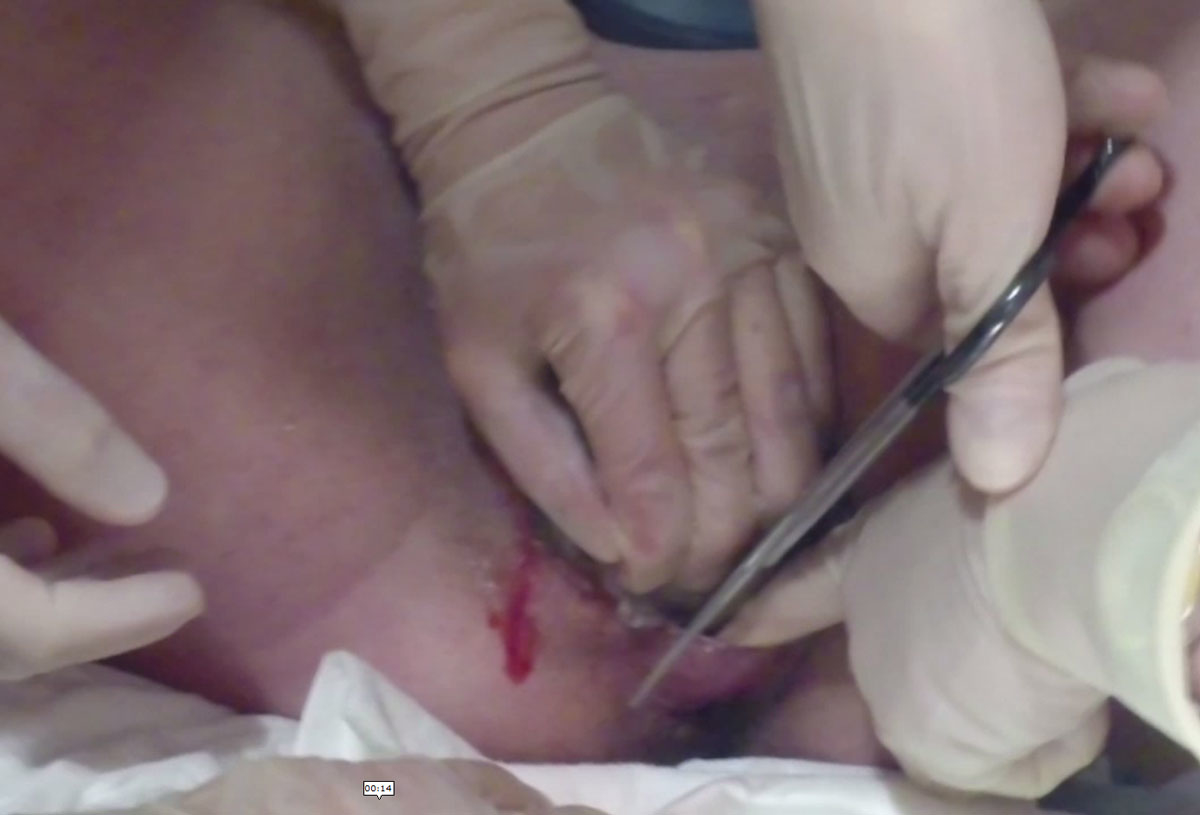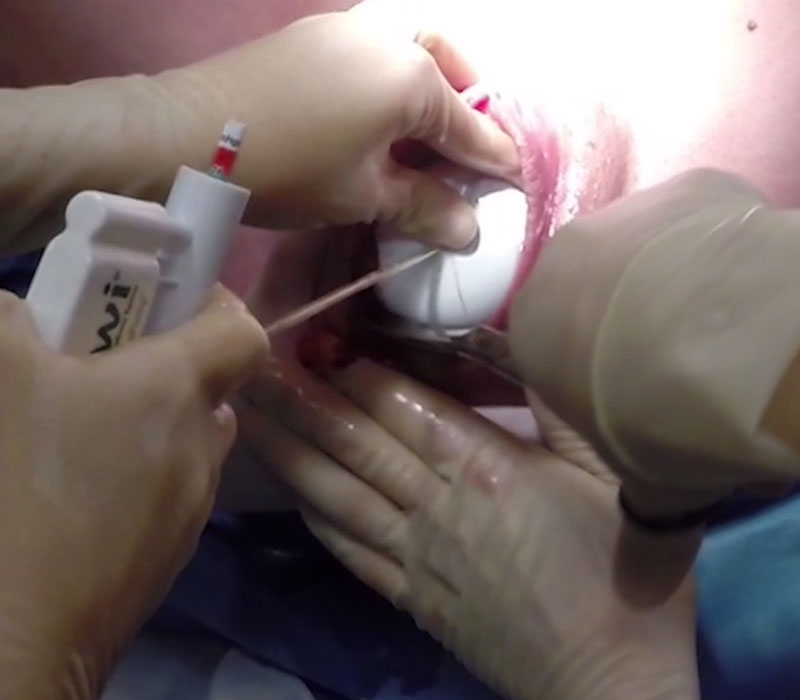
Figure1 Lack of visualisation of the perineum and uncoordinated staff, no sterile underlay.
DOI: https://doi.org/10.4414/smw.2018.14634
Video documentation is nowadays well established in many fields of medicine. It shows realistic situations and allows retrospective evaluation of procedures with visual and audio feedback, but mostly in unreal situations such medical education and simulation training. In clinical practice nowadays it is ever more important to evaluate, check and improve clinical procedures, especially in times of increasing focus on the legal aspects of medical work, and thus the medium “video” and its application in real time situations is expanding. Various publications have shown the application of video documentation in different medical settings and situations, especially neonatal resuscitation procedures [1–5]. Up to now, real-time video documentation in labour wards is still a rare source of quality control, as privacy at the special moment of giving birth is highly promoted, especially by midwives. In clinical practice, clinicians are often faced with a negative attitude towards observational procedures during birth, as they might interrupt and disturb the progress of labour, the unique moment of giving birth and the wellbeing of the persons involved. Nevertheless, observational procedures, such as video documentation, are helpful in analysing clinical situations with the staff involved, especially in absence of the woman and her family, in order to improve clinical outcomes. In our study, we aimed to describe the application, challenges and potential of video for teaching and learning purposes during birth.
As part of a prospective cohort study in the labour ward of the Division of Obstetrics at the University Hospital of Zurich, we recorded 100 vaginal births on video. Between February 2015 and June 2017, women over 18 years of age with singleton pregnancies with vertex presentation at term were included. Women expected to undergo vaginal delivery provided written informed consent before going into labour. The involved staff gave their informed consent to participate in the study in advance. The delivery of the head and body (crowning of the head and fetal extraction) with the manual actions and manoeuvres performed by the obstetric staff were recorded on video by the attending obstetrician. The obstetrician held a very small camera (GoPro® Hero 4 Black, GoPro Incorporation, USA) in his or her hand, standing next to the woman, usually opposite the midwife. If there was a need for active involvement of the responsible obstetrician in the birth process (e.g., for vacuum extraction or episiotomy), a second obstetrician was called for video recording. This was feasible as we always have two obstetricians on duty. Alternatively, the responsible obstetrician used a headband to fix the camera on his or her forehead to record the video and at the same time have the ability to use both hands.
The woman was free to move and the midwife free in her procedures, as long as she followed in-house standards (table 1). One obstetric senior consultant, who was responsible for the implementation of video recording in our labour ward and who is in general responsible for teaching our residents, afterward analysed the staff’s technical and nontechnical skills in the video sequences. Fields of interest were aseptic technique (application of a sterile underlay, use of sterile gloves), episiotomy technique if used (correct handling of the scissors regarding positioning and cutting angle), technique of fetal extraction by the midwife or obstetrician (fetal head slowdown as part of perineal protection, visualisation of the perineum, guidance of the hips, shoulders and arms and technique of vacuum-assisted extraction) and the communication between the woman and the staff. The detailed evaluation criteria are described in table 1.
Table 1 Evaluation criteria for the video records according to the in-house standard of care.
| Evaluation criteria | In-house standard of care | Discrepancy from in-house standard of care |
|---|---|---|
| Aseptic technique | Place sterile underlay under the bottom of the woman | No sterile underlay |
| Wear sterile gloves for vaginal examinations and fetal extraction | No sterile gloves | |
| Fetal extraction | Place one hand on the fetal head to hold back and slow down the fetal head during expulsion as part of perineal protection | Improper fetal head slowdown during expulsion |
| Visualise the perineum at every time during fetal extraction | Lack of perineal visualisation during fetal head expulsion and shoulder/body extraction | |
| Guide the fetal body including shoulders/arms/hips during fetal expulsion along the axis of the birth canal | Lack of guidance of the shoulders/arms/hips during extraction | |
| Technique of episiotomy | Place the curved surface of the scissors with the concave surface over the fetal head | Wrong handling of scissors |
| Place the scissors between two contractions | Wrong placement of scissors | |
| Perform mediolateral episiotomy with a cutting angle of 45–60° | Wrong cutting angle | |
| Communication between staff and woman | Communication with the woman and her partner should be adequate and coordinated: only one of the staff should lead communication. Instructions to the woman should be clear and easy to understand. Only one person should talk at the same time. | Improper communication between staff and woman: staff and woman/partner talk at the same time, partly with conflicting content |
| Technique of vacuum extraction | Place the cup between two contractions. Insert the cup parallel to the labia into the vagina to protect the surrounding tissue |
Improper positioning of the vacuum cup |
| Place the cup over the flexion point and perform a careful revision | Improper handling of the vacuum cup | |
| Place your thumb on the cup and the index finger on the fetal head during pulling. Pull along the axis of the birth canal |
Inappropriate pulling direction |
The study was approved by the local Ethics Board under the registration number KEK-ZH-Nr. 2014-0414 and registered in at ClinicalTrials.gov under the registration number NCT02295904.
A total of 480 patients were included in the umberella study, whereof 151 (31.46%) agreed to video recording. In 51 cases, the video was either not recorded, because labour ended in caesarean section or water birth, there was no time for video recording because of a fast birth process, or the video records taken were technically not useable. Nineteen patients (19%) gave birth by vacuum extraction and in 35% of the 100 births an episiotomy was performed. The characteristics of the study population are presented in table 2.
Table 2 Characteristics of the study population.
| Age in years | 33.51 ± 4.16 |
| Body mass index in kg/m2 | 22.45 ± 3.62 |
| Gestational age in weeks | 39.80 ± 1.15 |
| Parity | 1.47 ± 0.59 |
| Ethnicity | |
| Caucasian | 80 (80) |
| Non-Caucasian | 20 (20) |
| Birth mode | |
| Spontaneous | 81 (81) |
| Vacuum extraction | 19 (19) |
| Episiotomy performed | 35 (35) |
| Blood loss in ml | 499.00 ± 403.27 |
| 5-minute APGAR score <7 | 0 (0) |
| Umbilical artery pH | 7.24 ± 0.75 |
| Fetal weight in g | 3386.60 ± 408.06 |
| Fetal head circumference in cm | 34.81 ± 1.39 |
Values presented as mean ± standard deviation or n (%)
Video quality was mostly good or excellent, but the movements and the position of the women, and hands of the midwives covering the perineum affected quality (fig. 1).

Figure1 Lack of visualisation of the perineum and uncoordinated staff, no sterile underlay.
Fifty-nine out of 83 midwives (71.08%) within the study period gave their informed consent, whereas 24 (28.92%) did not agree to take part in the study. All of the obstetricians agreed to participate.
The introduction of video and its use during vaginal birth was initially resisted by some of the midwives. Arguments against video recording included fear of disturbance and interruption of the unique and intimate moment of birth, combined with fear of undesirable interventions by the attending obstetrician. Midwives also feared gaining a bad reputation owing to publication of the videos on the internet. Therefore, the woman was only allowed a copy of her video when the midwives and obstetricians involved gave their approval. Refusal of video documentation by the labouring woman and her partner was mostly based on fear that their intimate moment of birth and intimate parts of the body might be shown to other people and that the video camera might distract the woman’s concentration from the birthing process. However, women who accepted video documentation made no negative statements afterwards. Most of them did not even notice the camera during birth.
In the analysis of the 100 video sequences, important problems were frequently detected (table 3). These were inadequate asepsis (e.g., no sterile underlay in 7% or sterile gloves in 13% of cases; figs 1 and 2 ), improper fetal head slowdown during expulsion (in 7%), no visualisation of the perineum during extraction/expulsion of the fetal head (in 5%; fig 1) or shoulders/body (in 22%), no guidance of the shoulders/arms during extraction (in 7%), inappropriate episiotomy technique (wrong handling of the scissors in 1%, cutting angle too steep in 28%; figs 2 and 3 ) and inappropriate communication between the woman and the staff (midwives, obstetricians and the woman and her partner talking at the same time, partly even with conflicting content, in 11%, fig. 1, table 1). During vacuum-assisted extraction, improper positioning of the cup (in 21%), inappropriate direction of pulling (in 23%, fig. 3) and handling of the cup (in 39%) were recorded.
Table 3 Notable omissions during 100 vaginal births.
| n (%) | |
|---|---|
| No sterile underlay | 7 (7) |
| No sterile gloves | 13 (13) |
| Improper fetal head slowdown during expulsion | 7 (7) |
| Lack of perineal visualisation during fetal head expulsion | 5 (5) |
| Lack of perineal visualisation during shoulder/body extraction | 22 (22) |
| Lack of guidance of the shoulders/arms during extraction | 7 (7) |
| Wrong handling of episiotomy scissors | 1 (1) |
| Wrong cutting angle of episiotomy | 28 (28) |
| Improper communication between staff and woman | 11 (11) |
| Improper positioning of vacuum cup | 21 (21) |
| Inappropriate pulling direction | 23 (23) |
| Improper handling of vacuum cup | 39 (39) |

Figure 2 Incorrect episiotomy cutting angle (too steep), no sterile underlay.

Figure 3 Wrong handling of episiotomy scissors and inappropriate direction of pulling.
Video recording for the evaluation of medical procedures is mostly a well-accepted tool, even in the delivery room in the case of neonatal resuscitation [6]. No publication could be found regarding video documentation of the process of vaginal births itself.
The introduction of video documentation in the labour ward was a difficult and partly exhausting process, as recording of the birthing process on video is often regarded as violence against the birthing process and was therefore declined by midwives or the labouring woman and her partner. Undoubtedly, an atmosphere of privacy and an intimate environment have to be maintained. Informed consent must be obtained from all involved persons, as stated in the concept of respectful maternity care by the World Health Organization [7]. Besides that, midwives fear the intervention of obstetricians in the birthing process and the negative aspects of observation itself. They may think that they are being controlled in their primary field of work by obstetricians and be afraid of a possible accusation in cases of proposed “mismanagement”. It is an important component of the evaluation process to eliminate their fears and rejections and to refrain from personal accusations. Video documentation should be performed in an almost invisible, impersonal manner.
The personal rights of every involved individual staff member, the woman in labour and her partner must be protected. Therefore, the woman has to be informed in advance that she is allowed a copy of her birth video only if the staff agree (as his or her hands are recorded on the video). The video can only be used for presentations or teaching purposes with a wider audience (beyond the staff directly involved in the birth) with the consent of the labouring woman. Otherwise, there might be legal difficulties and the woman’s trust in the labour ward staff might be forfeited [8].
In the course of the study, there was a tendency toward an improvement in procedural quality. At the beginning of the study, the staff’s attention was mainly on the delivery of the fetal head; later, they focused more on visualisation of the perineum during the complete fetal expulsion and on guiding the fetal body. This seems favourable, as slowdown of the fetal head, manual protection and visualisation of the perineum, and controlled fetal expulsion are known to reduce the risk of anal sphincter tears [9–12]. Besides, it is known that more experienced birth attendants can reduce the rate of perineal damage [9]. The improvements seen might be explained by a learning curve, but also by the Hawthorne effect: an improvement in quality due to the staff’s awareness of video recording and supervision [13].
A limitation of the study might be the fact that only one senior consultant analysed the video sequences, although this consultant was well trained and familiar with the birthing and video scenario, as he was responsible for teaching our residents and for the implementation of video recording in our labour ward.
Video documentation contributes to the visualisation and evaluation of the actions of the labour ward staff during vaginal births. It allows self-recognition of “mistakes” or “deficits”, clarification of abilities and illustration of the interaction between the staff (midwife, obstetrician and maybe anaesthesiologist) and the woman. The video sequences can be analysed together with the involved staff after birth in absence of the woman and her family. Therefore, it is an excellent tool for education and self-training. It increases the supportive and medical quality of the midwives and obstetricians for the labouring women. Moreover, it contributes to medicolegal documentation and communication. In the future, it might help in correlating maternal and fetal birth outcomes with the recorded video sequences.
Video recording could also be implemented for several other scenarios inside the labour ward, such as different techniques of fetal breech extraction, suturing of birth traumas, routine caesareans and techniques of fetal extraction during second stage caesareans (especially in situations with an impacted fetal head).
In summary, video analysis of obstetric procedures in the labour ward is an easily applicable and very useful tool for teaching and learning purposes. An initial rejection was apparent, especially within the professional staff. Nonetheless, it contributes to the demonstration of the quality of processes and the interaction of the involved staff and helps on staff evaluation and education. It is a positive implementation for the overall quality of obstetrical procedures.
No financial support and no other potential conflict of interest relevant to this article was reported.
1 Schilleman K , Witlox RS , van Vonderen JJ , Roegholt E , Walther FJ , te Pas AB . Auditing documentation on delivery room management using video and physiological recordings. Arch Dis Child Fetal Neonatal Ed. 2014;99(6):F485–90. doi:.https://doi.org/10.1136/archdischild-2014-306261
2 O’Mahoney PR , Yeo HL , Lange MM , Milsom JW . Driving Surgical Quality Using Operative Video. Surg Innov. 2016;23(4):337–40. doi:.https://doi.org/10.1177/1553350616643616
3 Ho VY , Shah VG , Yates DM , Shah GK . GoPro HERO 4 Black recording of scleral buckle placement during retinal detachment repair. Can J Ophthalmol. 2017;52(4):416–8. doi:.https://doi.org/10.1016/j.jcjo.2016.12.009
4 van de Graaf FW , Menon AG , Lange MM . Een beeld zegt meer dan 1000 woorden [An image says more than a thousand words; standardising video registration in the operating theatre]. Ned Tijdschr Geneeskd. 2017;161(0):D498. Article in Dutch.
5 den Boer MC , Houtlosser M , van Zanten HA , Foglia EE , Engberts DP , Te Pas AB . Ethical dilemmas of recording and reviewing neonatal resuscitation. Arch Dis Child Fetal Neonatal Ed. 2018;103(3):F280–4.
6 Murphy MC , O’Donnell CPF , McCarthy LK . Attittudes of staff members towards video recording in the delivery room. Arch Dis Child Fetal Neonatal Ed. 2018;103(1):F85–6. doi:.https://doi.org/10.1136/archdischild-2017-313789
7 Shakibazadeh E , Namadian M , Bohren MA , Vogel JP , Rashidian A , Nogueira Pileggi V , et al. Respectful care during childbirth in health facilities globally: a qualitative evidence synthesis. BJOG. 2017. doi:.https://doi.org/10.1111/1471-0528.15015
8 Sailer R , Wienke A . Das Recht am eigenen Bild: Vorsicht bei Patientenfotos und Videodokumentation im Vortrag, bei Publikationen oder auf der Praxishomepage [The right to one’s own image: Caution required with patient photos and video documentation in talks, publications, and on the practice homepage]. HNO. 2018;66(5):403–4. Article in German. doi:.https://doi.org/10.1007/s00106-017-0437-6
9 Laine K , Pirhonen T , Rolland R , Pirhonen J . Decreasing the incidence of anal sphincter tears during delivery. Obstet Gynecol. 2008;111(5):1053–7. doi:.https://doi.org/10.1097/AOG.0b013e31816c4402
10 Samuelsson E , Ladfors L , Wennerholm UB , Gåreberg B , Nyberg K , Hagberg H . Anal sphincter tears: prospective study of obstetric risk factors. BJOG. 2000;107(7):926–31. doi:.https://doi.org/10.1111/j.1471-0528.2000.tb11093.x
11 Pirhonen J , Samuelsson E , Pirhonen T , Odeback A , Gissler M . Interventional program to reduce both the incidence of anal sphincter tears and rate of Caesarean sections. Eur J Obstet Gynecol Reprod Biol. 2018;223:56–9. doi:.https://doi.org/10.1016/j.ejogrb.2018.02.010
12 Hals E , Oian P , Pirhonen T , Gissler M , Hjelle S , Nilsen EB , et al. A multicenter interventional program to reduce the incidence of anal sphincter tears. Obstet Gynecol. 2010;116(4):901–8. doi:.https://doi.org/10.1097/AOG.0b013e3181eda77a
13 Rex DK , Hewett DG , Raghavendra M , Chalasani N . The impact of videorecording on the quality of colonoscopy performance: a pilot study. Am J Gastroenterol. 2010;105(11):2312–7. doi:.https://doi.org/10.1038/ajg.2010.245
No financial support and no other potential conflict of interest relevant to this article was reported.